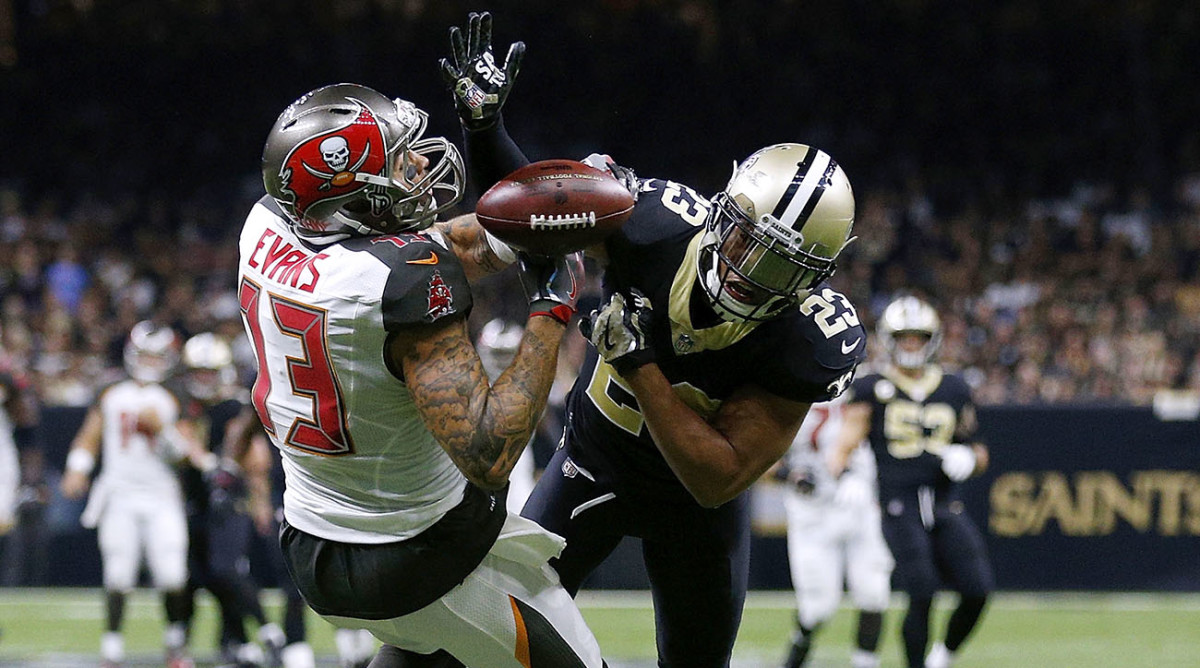How a Young Defense Is Making the Saints a Super Bowl Contender

In recent years, a 6-2 record for the Saints would portend a 1-7 finish. But not in 2017. A team that has gone 7-9 three years in a row (and four of the last five) is now a legitimate Super Bowl contender. And the reason is its defense.
This isn’t to say suggest that the Drew Brees-led offense is anything less than its usual sterling self. In fact, the addition of rookie back Alvin Kamara and surprising integration of speedster Ted Ginn has made the offense as dimensional as ever. But look at New Orleans’ current six-game winning streak: The defense is allowing 12.6 points and 264.7 yards an outing. The film has looked every bit as good as the numbers.
It starts in the secondary, particularly with first-round rookie Marshon Lattimore. He’s played as well as any corner in the league. His man coverage technique is freakishly smooth. His awareness in zone is veteran-like. In the rare instances where he has been beat, he’s shown outstanding recovery technique. This includes instances where the offensive play design has stressed the defensive call.

Lattimore’s fellow rookie, second-round free safety Marcus Williams, has been increasingly stellar in centerfield. And opposite Lattimore, Ken Crawley stole the starting job from the more gifted P.J. Williams. Crawley gets grabby at the top of vertical routes—penalties can be a problem—but that physicality serves him well everywhere else, including against quick slants.
Physical coverage is crucial because defensive coordinator Dennis Allen’s scheme needs corners to win one-on-one. This is the difference with the 2017 Saints defense versus the one that allowed 28.3 points per game (second-worst in the league) under Allen in ’16. (Note: Approximately three of those 28 points were from return scores against the offense or special teams.) Allen has long believed in an aggressive, voluminous scheme. He throws a lot at an offense and consequently, his own players.
The Bucs experienced this Sunday, all game long. Allen showed them a variety of pressure-oriented fronts (he loves to align someone directly over the center, which dictates one-on-one blocking assignments) and stung them with safety blitzes off the edge. Kenny Vaccaro, Vonn Bell and even little-used backup Chris Banjo made steady noise. Several times the pressure was disguised, something this defense has been superb with at times (the Week 6 Lions game comes to mind). Blitzing, especially when you’re disguising, requires extra bodies in the box, which can only be supplied if your corners can win on an island.
High-volume schemes like Allen’s tend to be high-risk, high-reward. (Saints fans might remember this from the Gregg Williams years.) But this defense, while making explosive plays regularly, has rarely been torched. Even more impressive, from snap-to-snap, you always notice how fast everyone plays. This has been a rally-to-the-ball defense, which typically only happens in simple, zone-based schemes.
This alone should get Allen, the 45-year-old ex-Raiders coach, interviews for a second crack at a head-coaching job. His defense is doing a lot of stuff, all at a torrid pace. What’s more, it’s a unit comprised mostly of youngsters and castoff veterans. Can this machine keep humming?
There are still some kinks that could be revealed if something goes wrong. For one, if Lattimore goes down, the whole thing malfunctions. (Of course, that’s true for many defenses and their best player.) For two, the linebacking unit, comprised of ex-Panther A.J. Klein and ex-Brown Craig Robertson (who signed here in 2016) is only as effective as the rest of the machine. When the D-line and secondary click, Klein and Robertson have the play recognition and sneaky quickness to be dynamic. But when there’s a glitch, Klein and Robertson can be exposed, especially in coverage.
And then there’s the pass rush. Aided by the blitzers and odd defensive fronts, it has benefitted from a lot of one-on-one blocking scenarios, which defenders are winning in front of a secondary that forces QBs to hold the ball. Augmenting this is the amount of high-energy, tenacious grinders the Saints have—guys like Alex Okafor, Hau’oli Kikaha (now healthy), David Onyemata (known more for his run defense) and intriguing third-round rookie Trey Hendrickson. And, of course, the king of second-effort playmaking (perhaps league-wide), Cameron Jordan.
But what this pass rush lacks is a true burner who can bend the corner off the snap. Jordan teases this when he’s facing lower-level right tackles, but overall his game is predicated on strength and technique, which he imposes on all levels of offensive tackles. Last year’s first-round pick, tackle Sheldon Rankins, flashed early-in-the-down play-wrecking traits as a rookie, but he’s had a mostly quiet sophomore campaign.
Remember though, the pass rush and linebacking unit are only problems if another problem shows up first. This defensive machine is fine-tuned, but with the parts all contingent on one another. When one falters, the rest will follow. But if no parts glitch, everything will keep humming smoothly enough for the Saints to remain contenders.
• Question or comment? Email us at talkback@themmqb.com.
